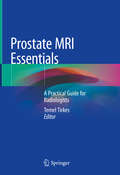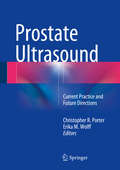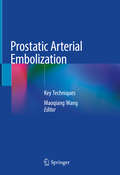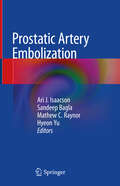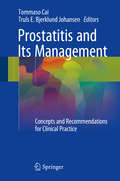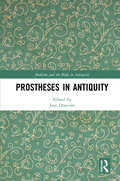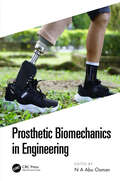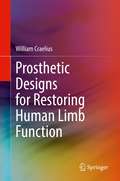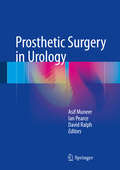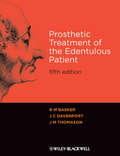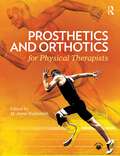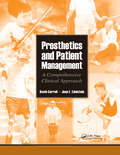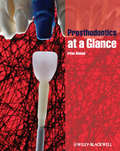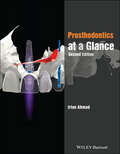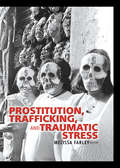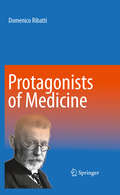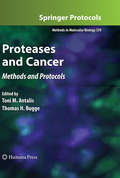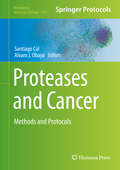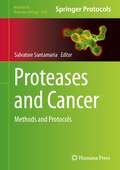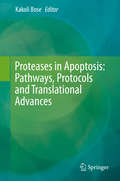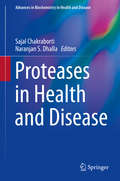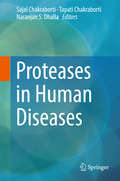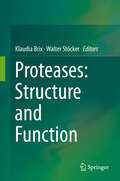- Table View
- List View
Prostate MRI Essentials: A Practical Guide for Radiologists
by Temel TirkesThis book is a basic, practical guide to performing and interpreting state-of-the-art prostate MRI, utilizing the latest guidelines in the field. Prostate MRI has become one of the fastest growing examinations in the radiology practice, and this demand has continuously increased within the past decade. Since it is relatively new, MRI of the prostate is predominantly being performed at academic institutions, however there is a growing demand within the lower-tier health care institutions to offer this examination to their patients. This is an ideal guide for radiologists who want to enhance or initiate prostate MRI service for their referring clinicians and as a manual for technologists and those who are in training. Prostate cancer is the second leading cause of cancer death in men, exceeded only by lung cancer. The best predictor of disease outcome lies with correct diagnosis, which requires precise imaging and diagnostic procedures aided by prostate MRI. Urologists, medical oncologists and radiation oncologists all agree that multi-parametric prostate MRI is essential for evaluation of prostate cancer. However, the technical aspects of prostate MR imaging are not as straightforward as for the other imaging modalities and constantly evolving. Its small size presents a real challenge to the radiologist, who needs to do the T2 and diffusion weighted images and perform a dynamic contrast enhanced sequence correctly. These images may also need to be analyzed on an independent workstation. Due to the absence of a current reference manual, when a radiologist wants to establish a prostate imaging service, he/she needs to attend dedicated prostate MR workshops or dive into the literature search alone, only to get more confused about what to do and how to do it. With this book, expert authors were asked to give clear guidance to those who want to enhance or initiate their prostate imaging service. With this much-needed, concise, practical guidance, radiologists can perform and interpret multi-parametric prostate MRI in a standardized fashion, in concordance with PI-RADS v2.1 that can be applicable to all available hardware platforms (GE, Philips, Siemens, Toshiba). Additionally, they can perform post-processing for possible targeted biopsy and interpret post-therapy and PET studies. The book discusses imaging protocols (planning and prescription) and sequence parameters with representative images for each MRI sequence. This handbook-style practical manual can be used in the radiology reading room by those interpreting the MR exam as a reference as well as at the MRI scanner by the technologists as a guide. Coverage of basic prostate anatomy, pathology, Urologists’ point of view, MRI guided radiation treatment planning and molecular imaging is also included. Throughout the book, authors will discuss basics, pitfalls, and provide tips in image acquisition and interpretation, alongside several case examples.
Prostate Ultrasound
by Christopher R. Porter Erika M. WolffProstate Ultrasound: Current Practice and Future Directions addresses the most up-to-date imaging techniques that incorporate ultrasound in the evaluation of prostate cancer. The volume features an important section on the applied physics of ultrasound and the future techniques that promise soon be to be routinely available as we continue to improve our ability to evaluate this optically illusive disease. The volume evaluates imaging of the prostate for the diagnosis and treatment of these benign conditions, and evaluates the future of pelvic floor ultrasound in the male. The general scope encompasses the physics of ultrasound, the technical aspects on the use of ultrasound, and the actual present day state of the art use of ultrasound in the treatment and diagnosis of men with prostatic issue. The volume also includes the unique feature of providing links to video clips that illustrate techniques of diagnostic ultrasound that will provide the reader with the foundation to perform accurate and safe ultrasound exams. Prostate Ultrasound: Current Practice and Future Directions will be of great value to urologists, radiologists, medical oncologists ultrasound technicians and fellows and residents in urology.
Prostatic Arterial Embolization: Key Techniques
by Maoqiang WangThis book provides a state-of-the-art review of the technical and clinical aspects of the arterial embolization procedures currently employed in treatment of prostate diseases. A particular focus is on artery embolization for benign prostate hyperplasia, whose efficacy is compared with transurethral resection and open prostatectomy. Additional chapters on application of PAE in the treatment of hematuria of prostatic origin and prostate malignant tumor are presented. Detailed information is provided on the full range of relevant topics, including prostatic artery anatomy, preoperative preparation, patient selection, embolization agents selection, and post embolization management. Complications and side-effects are also fully discussed. It will be a valuable reference for interventional radiologists and urological surgeons who perform the embolization procedures, as well as diagnostic radiologists and urological physicians interested in interventional procedures.
Prostatic Artery Embolization
by Ari J. Isaacson Sandeep Bagla Mathew C. Raynor Hyeon YuThis book comprehensively covers prostatic artery embolization (PAE) in interventional radiology (IR). PAE is a recently developed procedure primarily for the treatment of benign prostatic hyperplasia (BPH). BPH is an extremely common problem, affecting the urination of about half of men over the age of 50. PAE is a minimally invasive IR procedure that improves urinary symptoms secondary to BPH and, unlike most available BPH treatments, carries very little risk of compromising sexual function. It should be noted, however, that PAE is known to be a very difficult procedure due to the variations in pelvic arterial anatomy and small diameter of the target vessels. Because of the inherent challenge, interventional radiologists need resources to learn how to perform PAE, so they can add this exciting new procedure to their practice. This comprehensive, yet compact, text covers everything from patient evaluation, through procedure, and finally how to deal with failure or repeat procedures. Expert authors who are responsible for more than a third of PAEs performed in the United States include best practices and detailed steps for performing PAE, with potential pitfalls and related issues considered. Readers should come away from reading the text feeling confident in being able to provide PAE to their patients, whether it be for BPH, hemorrhage, or hematuria. This is an ideal guide for interventional radiologists hoping to learn or improve their skills for PAE.
Prostatitis and Its Management
by Tommaso Cai Truls E. Bjerklund JohansenThis book provides comprehensive coverage of the current and emerging management of prostatitis, from diagnosis to therapy. It addresses all clinical aspects of the prostatitis syndrome and equips the reader with all the information needed to offer a tailored therapy. Furthermore, clinical implications of the disease are analyzed and discussed, with particular attention to andrological complications (infertility) and the possible link between prostatitis and prostate cancer. Special consideration is also given to contemporary aspects of prostatitis management relating to antibiotic stewardship and elevated PSA, bearing in mind that thoughtless treatment of prostatitis represents malpractice and sometimes even a forensic issue. The final chapter comprising questions and answers will be valuable for quick consultation in everyday clinical practice. This book will be a truly practical guide for physicians involved in the diagnostic work-up and treatment of patients suspected of having prostatitis and will also serve as a ready source of information for all physicians who occasionally see prostatitis patients.
Prostheses in Antiquity (Medicine and the Body in Antiquity)
by Jane DraycottToday, a prosthesis is an artificial device that replaces a missing body part, generally designed and assembled according to the individual’s appearance and functional needs with a view to being both as unobtrusive and as useful as possible. In classical antiquity, however, this was not necessarily the case. The ancient literary and documentary evidence for prostheses and prosthesis use is contradictory, and the bioarchaeological and archaeological evidence is enigmatic, but discretion and utility were not necessarily priorities. So, when, howand why did individuals utilise them? This volume, the first to explore prostheses and prosthesis use in classical antiquity, seeks to answer these questions, and will be of interest to academics and students with specialistinterests in classical archaeology, ancient history and history, especially those engaged in studies of healing, medical and surgical practices, or impairment and disability in past societies.
Prosthetic Biomechanics in Engineering
by Osman AbuProsthetic biomechanics is an interdisciplinary field of engineering, medicine, and biology, focused on enhancing people’s lifestyles. In the past 20 years, the field of prosthetic biomechanics and its potential have grown due to the support of advances in engineering technologies. Prosthetic Biomechanics in Engineering is about the recent advances in prosthetic engineering research. The scope of the book is focused on the design, development, and evaluation of a prosthetic systems that are being used in biomechanical applications. The book covers advanced materials, conceptual design, classification, ergonomics design applications, brain computer interface (BCI) system, motion analysis, postural stand stability, upper and lower limb prosthetics, types of suspension systems for prosthetics, Fiber Bragg Grating-based techniques, and pressure on the residual limb and the socket. The early chapters effectively describe new sensors for in-socket systems, new pylon material, and advanced gait analysis. Further chapters discuss advanced techniques for the design and development of prosthetics based on clinical and emergency uses. The information provided in this book is intended for researchers and investigators to encourage further advances in the field of prosthetics research, and for the development of rehabilitation equipment for the improvement of human health, and it: Presents recent advances in prosthetic biomechanics engineering research Discusses the design and development of limb prosthetic systems Explores advanced concepts of the prosthetic sockets Describes gait analysis of prosthetics and orthotics Dr Noor Azuan Abu Osman is a practicing engineer and Professor of Biomechanics with Department of Biomedical Engineering, Faculty of Engineering, University of Malaya, Malaysia.
Prosthetic Designs for Restoring Human Limb Function
by William CraeliusThis textbook provides a thorough introduction and overview of the design and engineering of state-of-the-art prosthetics and assistive technologies. Innovations in prosthetics are increasingly made by cross-disciplinary thinking, and the author introduces the application of biomedical, mechanical, electrical, computer, and materials engineering principles to the design of artificial limbs. Coverage includes the fundamentals of biomechanics, biomechanical modeling and measurements, the basics of anatomy and physiology of limb defects, and the historical development of prosthetic design. This book stimulates the innovative thinking necessary for advancing limb restoration, and will be essential reading for students, as well as researchers, professional engineers, and prosthetists involved in the design and manufacture of artificial limbs.Learning enhanced by the exercises, including physical modeling with MATLAB and Simulink;Includes appendices with relevant equations and parameters for reference;Introduction to the design and engineering of prosthetics and assistive technologies.
Prosthetic Surgery in Urology
by Asif Muneer Ian Pearce David RalphUrologists interested in prosthesis surgery currently offer a range of procedures eg slings for incontinence in both men and women, and is also within the remit of those undertaking AUS (artificial urinary sphincter) implantation, and likewise andrological surgeons undertaking penile prosthesis also offer AUS. There are a number of procedures which are common to all urologists with a general urology practice eg ureteric stents and testicular implants. However, the purpose of this book is to cover this area of urological surgery and provide a reference book for those interested in expanding their practice.
Prosthetic Treatment of the Edentulous Patient
by J. C. Davenport R. M. Basker J. M. ThomasonThe new edition of this well established and highly regarded textbook has been completely revised and updated to reflect the latest developments in the field of tooth loss and denture provision. Primarily aimed at students in the undergraduate and immediate postgraduate years, it will also be of value to all those, including clinical dental technicians, who are faced with the increasingly challenging problems of complete denture treatment in dental practice.Starting with a thorough grounding in the background and theory of denture treatment, the book goes on to describe clinical procedures for all stages of treatment as well as devoting a chapter to the diagnosis and management of clinical problems. The clinical chapters also include sections on quality control, where topics are suggested for consideration in audit cycles.Now in full colour throughout, this fifth edition of Prosthetic Treatment of the Edentulous Patient contains over 100 illustrations and also includes a brand new section on implant overdentures.Stresses the importance of evidence-based treatmentEmphasises care of the elderly and the value of holistic treatmentUses a flexible approach to accommodate patient variationHighlights the importance of good communication between clinician and dental technicianIncludes many high-quality full colour illustrations
Prosthetics and Orthotics for Physical Therapists
by M. Jason HighsmithProsthetics and Orthotics for Physical Therapists provides physical therapy students, physical therapists, and other allied health clinicians with foundational knowledge in prosthetic and orthotic (P&O) topics. The text and its resources are efficient, impactful, and affordable, including an overview of the history of amputation, and artificial limb, prosthetic, and orthotic concepts, followed by a review of professional and educational concepts related to P&O.Prosthetics and Orthotics for Physical Therapists is divided into two sections: first, Prosthetics and second, Orthotics. The Prosthetics section includes chapters on amputation epidemiology, related surgical concepts, componentry, gait, therapy, outcomes, and dermatologic considerations, as well as lower and upper extremity amputation principles and concepts. In the Orthotics section, there is an overview of pathology, and chapters on orthotic principles primarily by body region including below and above the knee, spinal and chest, and cranial and upper extremity.Key features and benefits of the book include the concise but clinically focused topics which are supported by evidence when available, and the covering of historic concepts through to the latest topics such as osseointegration and microprocessor-controlled devices. The organization by prosthetic and orthotic divisions, the anatomic and regional body section divisions, and the special topics (i.e., history, epidemiology, education, and others) allows discrete compartmentalization of vast content. This cutting-edge new textbook is ideal for entry level clinicians in training such as physical therapists, occupational therapists, physicians, prosthetists/orthotists, or others in physical rehabilitative disciplines. Additionally, the book may serve well as a desk reference for clinicians who may not be specialized in P&O care but manage patients who utilize P&O devices.
Prosthetics and Patient Management: A Comprehensive Clinical Approach
by Kevin Carroll Joan EdelsteinProsthetics and Patient Management: A Comprehensive Clinical Approach is an innovative text covering both upper and lower extremity prosthetics. All the information clinicians need to manage a range of patients with amputations and their disorders is available in this practical and all-inclusive text. Kevin Carroll and Joan E. Edelstein, together with internationally recognized leaders, present a multidisciplinary team approach to the care of a patient with an amputation. Prosthetics and Patient Management covers practical solutions to everyday problems that clinicians encounter, from early prosthetic management to issues facing the more advanced user. The text is divided into four sections encompassing the range of subjects that confront practitioners including Early Management; Rehabilitation of Patients with Lower Limb Amputation; Rehabilitation of Patients with Upper Limb Amputations; and Beyond the Basics, which includes special considerations for children and futuristic concepts. Prosthetics and Patient Management will provide expert guidance for dealing with a wide array of patients and is a must-have for clinicians and students in physical therapy, certified prosthetists, and orthopedists interested in the wide-ranging field of prosthetics and amputations.
Prosthodontics at a Glance
by Irfan AhmadProsthodontics at a Glance is a title in the popular At A Glance series and focuses on prosthodontics from diagnostics through treatment to post-operative maintenance. It is an ideal companion for all students of dentistry, clinicians and members of the dental team with an interest in prosthodontics.
Prosthodontics at a Glance (At a Glance (Dentistry))
by Irfan AhmadThe market‐leading at a Glance series is popular among students and newly qualified practitioners for its concise and simple approach and excellent illustrations. Each bite-sized chapter is covered in a double‐page spread with clear, easy-to-follow diagrams, supported by succinct explanatory text. Covering a wide range of topics, books in the at a Glance series are ideal as introductory texts for teaching, learning and revision and are useful throughout university and beyond. Everything you need to know about Prosthodontics… at a Glance! Prosthodontics at a Glance is the must-have companion for all dentistry students and practitioners interested in oral rehabilitation with artificial prostheses. Brief userfriendly chapters allow for rapid reference to all major sub-topics of prosthodontic dentistry, including treatment planning, decision making, periodontal and endodontic considerations, posts and cores, tooth preparation, dental implants, occlusion procedures, dental restorations, aesthetics, and more. The second edition incorporates the latest techniques and scientific advances in prosthodontics, featuring 25 brand-new chapters on topics such as digital dentistry, bioactive materials, artificial intelligence, tissue engineering, stem cells, ethical considerations in elective dental procedures, dental laser technology, and the use of CAD/CAM applications in the clinic and dental laboratory. Written by a knowledgeable clinician, Prosthodontics at a Glance 2nd Edition: Contains extensively updated and expanded material throughout Covers the spectrum of prosthodontic treatments, including intra- and extra-coronal restorations, and removable prostheses Features new coverage of 3D printing, intra-oral scanners, digital workflows and diagnoses, smile design, shade assessment, and facial enhancement using dermal fillers Includes full colour diagrams and clinical photographs Prosthodontics at a Glance 2nd Edition is an invaluable resource for dental students preparing for examinations, as well as for working dental care professionals looking for an easy-to-use reference guide.
Prostitution, Trafficking, and Traumatic Stress
by PhD, Melissa FarleyProstitution, Trafficking, and Traumatic Stress offers the reader an analysis of prostitution and trafficking as organized interpersonal violence. Even in academia, law, and public health, prostitution is often misunderstood as "sex work." The book&’s 32 contributors offer clinical examples, analysis, and original research that cou
Protagonists of Medicine
by Domenico RibattiThe study of medical history is interesting in itself and may help to modify the view sometimes expressed that medical students and doctors are lacking in culture of any sort. Moreover, some historical perspective is often advantageous when one is considering the multitude of advances that are now taking place in the theory and practice of medicine. This book, containing a series of collected papers concerning immunology and pathology and vascular biology and angiogenesis, drives us through scientific milestones in the history of medicine in the course of the past two centuries and highlights the contribution of pioneering scientists whose discoveries have paved the way to many researchers working in the fields of cell biology, developmental biology, immunology, pathology, and oncology. This book will serve as a resource for scientists, historians of medicine and philosophers of science and medicine.
Proteases and Cancer
by Thomas H. Bugge Toni M. AntalisProteases decisively contribute to cancer development and promotion by regulating the activities of growth factors/cytokines and signaling receptors, as well as the composition of the extracellular matrix, thereby suppressing cell death pathways and activating cell survival pathways. In Proteases and Cancer: Methods and Protocols, expert researchers bring together a wide range of current, complimentary techniques that have been developed for the specific detection and analysis of proteases and their activities in cancer biology. The volume covers vital topics including the application of proteomics technologies for the detection of protease expression in tumors, imaging proteases by activity profiling, proteomics technologies for the identification of biological substrates, detection of cell surface proteolysis, imaging of protease activity, the use of transgenic mice to determine protease function in tumor initiation and progression, and the development of anti-protease therapies for cancer. Written in the highly successful Methods in Molecular BiologyTM series format, chapters include introductions to their respective topics, lists of the necessary materials and reagents, step-by-step, readily reproducible laboratory protocols, and notes on troubleshooting and avoiding known pitfalls. Authoritative and easy to use, Proteases and Cancer: Methods and Protocols is an ideal guide for scientists who wish to pursue the study of this important branch of cancer research and the development of unique innovative technologies to aid in that study.
Proteases and Cancer: Methods And Protocols (Methods In Molecular Biology #1731)
by Santiago Cal Alvaro J. ObayaThis volume explores the role of proteases in various catalytic classes and cellular processes associated with cancer. The chapters in this book cover topics such as encoding proteolytic enzymes, cleavage sites of proteases, functional catalytic domains of MMPs, zymography, angiogenesis and lymphangiogenesis, genetic and epigenetic alterations of metallopeptidases, and methods to target metalloproteinases. Written in the highly successful Methods in Molecular Biology series format, chapters include introductions to their respective topics, lists of the necessary materials and reagents, step-by-step, readily reproducible laboratory protocols, and tips on troubleshooting and avoiding known pitfalls. Comprehensive and cutting edge, Proteases and Cancer: Methods and Protocols is a valuable resource for clinical researchers across numerous fields such as molecular and cellular biology, oncology, biochemistry, and chemistry. This book is also useful for PhD students in the various disciples of health sciences.
Proteases and Cancer: Methods and Protocols (Methods in Molecular Biology #2747)
by Salvatore SantamariaThis volume details bioinformatics analysis, biochemical assays, recombinant protein expression and purification, methods to investigate protease activity in cell-based, organoids and in vivo systems, proteomics, transcriptomics, machine learning and novel approaches to target dysregulated protease activity in cancer. Written in the highly successful Methods in Molecular Biology series format, chapters include introductions to their respective topics, lists of the necessary materials and reagents, step-by-step, readily reproducible laboratory protocols, and tips on troubleshooting and avoiding known pitfalls. Authoritative and cutting-edge, Cancer Immunotherapy: Methods and Protocols aims to provide the scientific community with a diverse and representative collection of state-of-the-art methods to investigate the protean functions of proteases in cancer biology.
Proteases and Their Receptors in Inflammation
by Michel Chignard Nathalie VergnolleProteases are everywhere from prokaryotes to eukaryotes, from virus to bacteria and in all human tissues, playing a role in many biological functions. Among these functions, the inflammatory reaction is of particular interest. In inflamed tissues, proteases can have a microbial and/or host origin and are involved not only in tissue remodeling, but also in specific signaling to resident or inflammatory cells, thereby contributing to the innate immune response. This volume presents all advances in our knowledge of the role proteases and their inhibitors play in various diseases associated with inflammatory response. Mechanisms involved in protease signaling to cells are presented, and the different types of proteases that are present at inflammatory sites and their effects on the course of inflammation are discussed. Finally, the evidence for considering proteases and their receptors as potential molecular targets for therapeutic interventions in the treatment of inflammatory diseases is discussed in the context of specific organ inflammatory pathologies (the lung, gastrointestinal tract, skin, joints, etc.).
Proteases in Apoptosis: Pathways, Protocols and Translational Advances
by Kakoli BoseThis book provides a comprehensive overview of the proteases involved in programmed cell death. It presents a focused yet extensive discussion on proteolytic enzymes such as caspases, HtrAs, granzymes, calpains and cathepsins as well as laboratory protocols related to enzymology and apoptosis. Mouse model systems and non-invasive imaging techniques in apoptosis-related diseases such as cancer and neurodegeneration are also covered in this book. While slowly unravelling the complexities of apoptosis in chapter one, the next three chapters individually elaborate on different classes of proteases that play key roles in the initiation, progression and execution of programmed cell death. The last two chapters complete this discussion by describing different laboratory methodologies and therapeutic advances involving apoptotic proteases. Protocols portraying in vitro and ex vivo colorimetric and fluorescence-based enzyme kinetic studies as well as cell death assays are explained in the fifth chapter. Preclinical in vivo models and non-invasive imaging in apoptosis to understand the complexities of disease progression and their contribution toward therapeutics is recounted in the last chapter. The book spans topics related to both fundamental and applied biology. It would therefore be equally appealing and informative to scientists working in the field of apoptosis and those who are investigating mechanisms of proteases and enzymes in general. The protocols would certainly benefit both graduate and undergraduate students working in the related fields and provide useful leads for drug design to translational biologists involved in neurodegeneration and cancer research.
Proteases in Health and Disease
by Naranjan S. Dhalla Sajal ChakrabortiIn view of rapidly growing research in the deregulation of proteases and their impact in human health and diseases, this book will highlight existing and emerging research in this exciting area. In-depth critical state-of-the-art reviews will be written by established investigators on proteases dysfunctions associated with pathogenesis of different diseases that are known to occur due to deregulation of proteolytic systems. Multidisciplinary approaches demonstrating biochemical and signal transduction mechanisms associated with deregulation of proteases leading to manifestation of the diseases will be discussed. The book highlights the roles of both intracellular and extracellular proteases in health and disease.
Proteases in Human Diseases
by Naranjan S. Dhalla Sajal Chakraborti Tapati ChakrabortiThis book bridges the gap between fundamental research and biomedical and pharmacological applications on proteases. It represents a comprehensive overview of the multifaceted field of proteases in cellular environment and highlights the recently elucidated functions of complex proteolytic systems in different diseases. Several established investigators have elucidated the crucial role of proteases in biological processes, including how proteolytic function and regulation can be combined to develop new strategies of therapeutic interventions. Proteases form one of the largest and most diverse families of enzymes known. It is now clear that proteases are involved in every aspect of life functions of an organism. Under physiological conditions, proteases are regulated by their endogenous inhibitors; however, when the activity of proteases is not regulated appropriately, disease processes can result in. So, there is absolute need for a stringent control of proteolytic activities in cells and tissues. Dysregulation of proteases may cause derangement of cellular signalling network resulting in different pathophysiological conditions such as vascular remodelling, atherosclerotic plaque progression, ulcer and rheumatoid arthritis, Alzheimer disease, cancer metastasis, tumor progression and inflammation. Additionally, many infective microorganisms require proteases for replication or use proteases as virulence factors, which have facilitated the development of protease-targeted therapies for a variety of parasitic diseases.
Proteases: Structure and Function
by Klaudia Brix Walter StöckerProteolysis is an irreversible posttranslational modification affecting each and every protein from its biosynthesis to its degradation. Limited proteolysis regulates targeting and activity throughout the lifetime of proteins. Balancing proteolysis is therefore crucial for physiological homeostasis. Control mechanisms include proteolytic maturation of zymogens resulting in active proteases and the shut down of proteolysis by counteracting endogenous protease inhibitors. Beyond the protein level, proteolytic enzymes are involved in key decisions during development that determine life and death - from single cells to adult individuals. In particular, we are becoming aware of the subtle role that proteases play in signaling events within proteolysis networks, in which the enzymes act synergistically and form alliances in a web-like fashion. Proteases come in different flavors. At least five families of mechanistically distinct enzymes and even more inhibitor families are known to date, many family members are still to be studied in detail. We have learned a lot about the diversity of the about 600 proteases in the human genome and begin to understand their physiological roles in the degradome. However, there are still many open questions regarding their actions in pathophysiology. It is in this area where the development of small molecule inhibitors as therapeutic agents is extremely promising. Approaching proteolysis as the most important, irreversible post-translational protein modification essentially requires an integrated effort of complementary research disciplines. In fact, proteolytic enzymes seem as diverse as the scientists working with these intriguing proteins. This book reflects the efforts of many in this exciting field of research where team and network formations are essential to move ahead.
Protect Yourself from Electromagnetic Pollution by Using Crystals
by Barbara NewerlaThe definitive guide to crystals and electronic contamination, this guidebook explains how and when these healing rocks can provide relief. Electromagnetic pollution, also known as electrosmog, from mobile phones, computers, microwaves, hearing aids, televisions, radios, and even calculators, can cause or aggravate a number of disorders, including fatigue, irritability, aggression, hyperactivity, insomnia, and emotional instability. This convenient reference provides useful pictures of which crystals to employ along with short descriptions of how they combat these conditions, which in some cases can cause convulsions, memory problems, and depression. Concise and practical, this is the essential handbook to protecting against modern-day environments.
